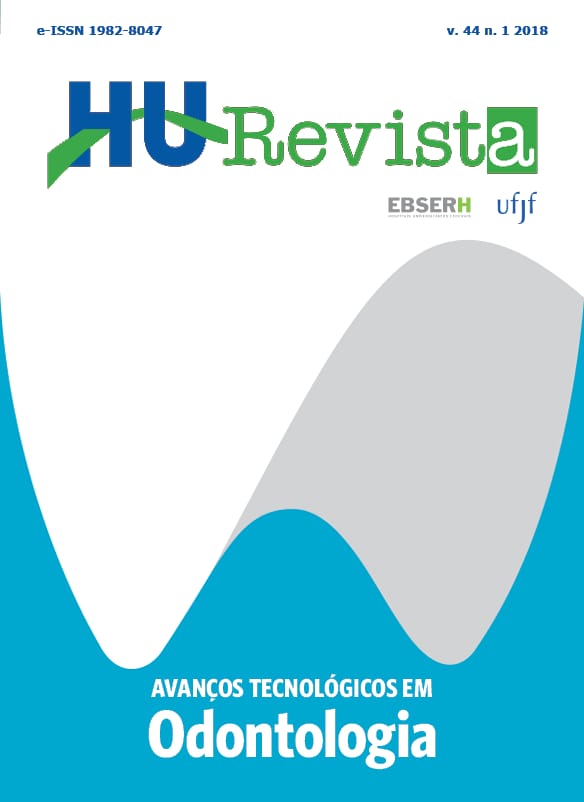Condilectomia alta associada à discopexia, com mini-âncoras, no tratamento da hiperplasia condilar: relato de caso
DOI:
https://doi.org/10.34019/1982-8047.2018.v44.13941Palavras-chave:
Hiperplasia Condilar. Condilectomia. Assimetria facial.Resumo
Introdução: A hiperplasia condilar (HC) é uma patologia rara caracterizada por crescimento não neoplásico que afeta a morfologia do côndilo mandibular com deformação progressiva. Dentre os sinais mais comuns se encontram a assimetria facial e mandibular, além de possíveisalterações oclusais como mordida aberta ipsilateral e transversal contralateral. Objetivo: O objetivo do estudo foi demonstrar a eficácia terapêutica da condilectomia alta associada à discopexia, com mini-âncoras, no tratamento da hiperplasia condilar. Relato de caso: Paciente de 24 anos de idade, apresentando assimetria facial, déficit e incompetência funcional mastigatória, mordida aberta posterior ipsilateral e mordida cruzada posterior contralateral. A proposta terapêutica escolhida foi o tratamento cirúrgico com condilectomia alta e discopexia com âncora para estabilização do disco articular, através de acesso endaural para o côndilo afetado com tamponamento auricular. Foi realizado infiltração com ácido hialurônico intra-articular após sutura da cápsula articular e sutura por planos para sutura da pele. Conclusão: A condilectomia alta preveniu a progressão da deformidade facial, minimizando as sequelas funcionais e estéticas, o que visa a favorecer o tratamento das deformidades faciais através de correção ortognática em segundo momento cirúrgico.
Downloads
Referências
CAI X, JIN J, YANG C. Changes in Disc Position, Disc Length,and Condylar Height in theTemporomandibular Joint With Anterior Disc Displacement: A Longitudinal Retrospective Magnetic Resonance Imaging Study.J Oral MaxillofacSurg, v. 69, p.340-346, 2011.
FARIÑA R, OLATE S, RAPOSO A, ARAYA I, ALISTER JP, URIBE F. High condylectomy versus proportional condylectomy: is secondary orthognathic surgery necessary?Int J Oral MaxillofacSurg,v.45, p.72–77, 2016.
GHAWSI S, AAGAARD E, THYGESEN TH. High condylectomy for the treatment of mandibular condylar hyperplasia: a systematic review of the literature. Int J Oral MaxillofacSurg,v.45,p.60–71,2016
HERNÁNDEZ FA, MÉNDEZ IM, VALLS AO, Guijarro RM. Minimally invasive intraoral condylectomy: proof of concept report, Int J Oral MaxillofacSurg, 2016.
LIPPOLD C, KRUSE-LOSLER B, DANESH G, JOOS U, MEYER U. Treatment of hemimandibular hyperplasia: the biological basis of condylectomy. Br J Oral MaxillofacSurg,v.45,p.353-60, 2007.
LÓPEZ DF, ARISTIZÁBAL JF, MARTÍNEZ-SMIT R. Condylectomy and "surgery first"approach: An expedited treatment for condylar hyperplasia in a patient withfacial asymmetry. Dental Press J Orthod,V.22,n.4,p.86-96, Jul-Aug.2017.
LÓPEZ DF, CORRAL CM. Hiperplasia condilar: características, manifestaciones, diagnóstico y tratamiento. Revisión de tema. RevFacOdontolUnivAntioq,v.26, n.2, p.425-446, 2015.
NITZAN DW, KATSNELSON A, BERMANIS I, BRIN I, CASAP N. The clinical characteristics of condylar hyperplasia: experience with 61 patients. J Oral MaxillofacSurg,v.66,p.312-318,2008.
OLATE S, MORAES, M. Asymmetric facial deformity. Role of condylar hyperplasia. Int J Odontostomat,v.6,n.3, p.337-347,2012.
OLATE S, NETTO HD, RODRIGUEZ-CHESSA J, ALISTER JP, DE ALBERGARIA-BARBOSA J, DE MORAES M.Mandiblecondylarhyperplasia: a reviewofdiagnosisandtreatmentprotocol. Int J ClinExpMed,v.6, p.727-737, 2013.
PULGAR D, GONI I, REINOSO C, SCHULZ R, HORMAZABAL F, VARGAS Al.Hiperplasia de condilo mandibular: reporte de 12 casos. RevOtorrinolaringolCirCabezaCuello,v.75,p. 27-34, 2015.
SARIDIN CP, GILIJAMSE M, KUIK DJ, TEVELDHUIS EC, TUINZING DB, LOBBEZOO F. Evaluation of temporomandibular function after high partial condylectomy because of unilateral condylar hyperactivity. J Oral MaxillofacSurg,v.68,p.1094-1099, 2010.
VILLANUEVA-ALCOJOL L, MONJE F, GONZÁLEZ-GARCÍA R. Hyperplasia of the mandibular condyle: clinical, histopathologic, and treatment considerations in a series of 36 patients. J Oral MaxillofacSurg, v.69, p.447-455, 2011.
ZAPATA S, MEDINA H, SARAVIA D, NAVARRO P, OLATE S. Morphometric analysis of the mandible in patients with facial asymmetry associated to condylar hyperplasia. A panoramic radiography study. Int J Morphol,v.32,n.1,p.161-165, 2014.
WESTESSON PL, YAMAMOTO M, SANOT ,OKANO T. jaws and temporomandibularjoints,p. 995-1053, 2003.
WOLFORD LM, MEHRA P, REICHE-FISCHEL O, MORALES-RYAN CA, GARCÍA-MORALES P. Efficacy of high condylectomy for management of condylar hyperplasia.Am J OrthodDentofacialOrthop,v.121, n.2, p.136-151, 2002.
WOLFORD LM, MORALES-RYAN CA, GARCÍA-MORALES P, PEREZ D. Proc (BaylUniv Med Cent) v.22,n.4,p.321–329, 2009.
WOLFORD LM, MOVAHED R, DHAMEJA A, ALLEN WR. Low condylectomy and orthognathic surgery to treat mandibular condylar osteo-chondroma: a retrospective review of 37 cases. J Oral MaxillofacSurg,v.72, p. 1704–1728, 2014.
WU C, MENG Q, DENG M, CAI H, KE J, LONG X. Cone-beam computed tomographicanalysis of maxillary and mandibular changes after high condylectomycombinedwith orthodontic treatment for active unilateral condylar hyperplasia. Br J Oral MaxillofacSurg,V.56, n.8, p. 692-697,Oct,2018.
WOLFORD LM, MOVAHED R, PEREZ DE: A classification system for conditions causing condylar hyperplasia. J Oral Maxillofac Surg 72:567, 2014.
Downloads
Arquivos adicionais
Publicado
Como Citar
Edição
Seção
Licença
Cessão de Primeira Publicação à HU Revista
Os autores mantém todos os direitos autorais sobre a publicação, sem restrições, e concedem à HU Revista o direito de primeira publicação, com o trabalho licenciado sob a Licença Creative Commons Attribution que permite o compartilhamento irrestrito do trabalho, com reconhecimento da autoria e crédito pela citação de publicação inicial nesta revista, referenciando inclusive seu DOI.









